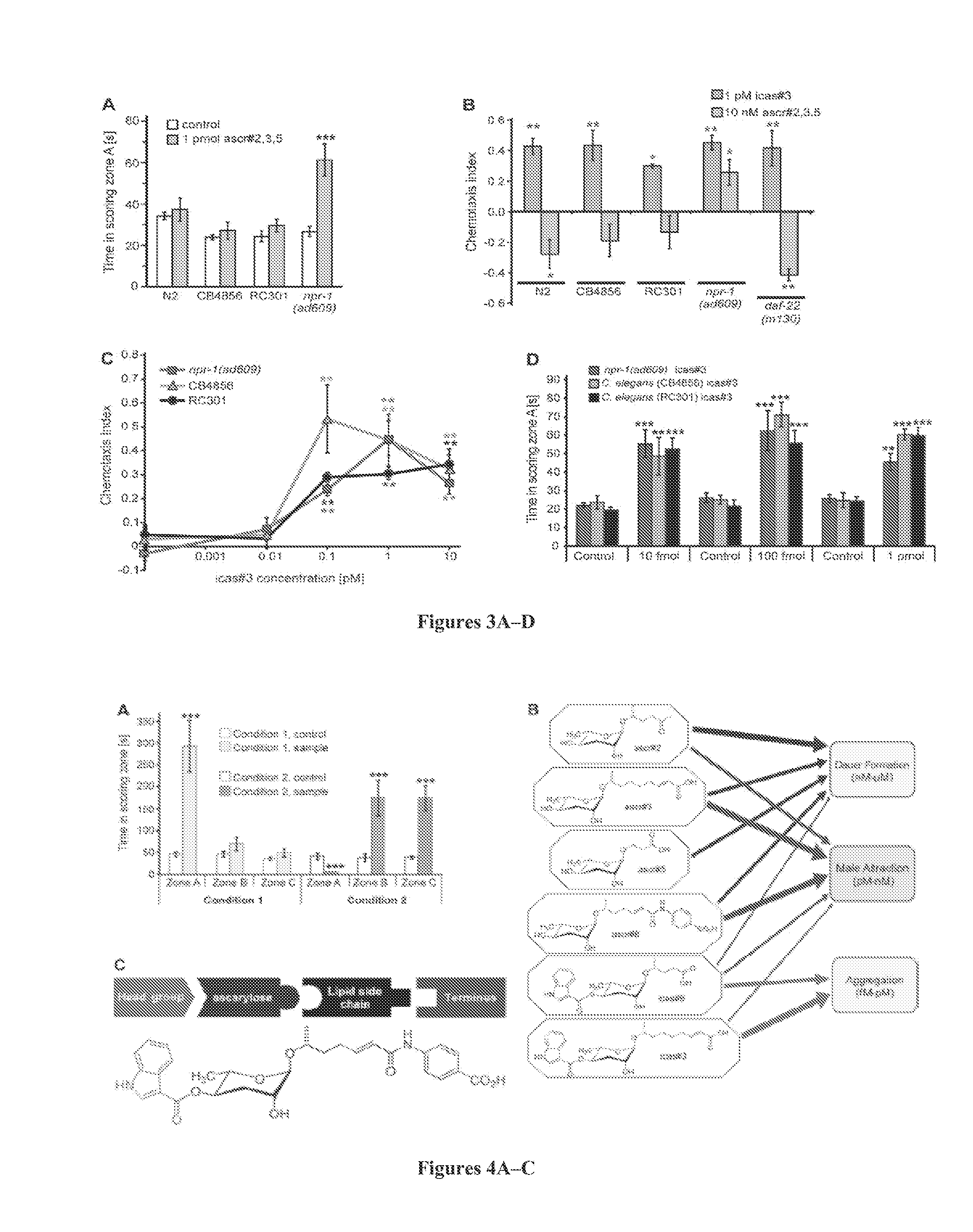Small Molecule Compounds That Control Plant- and Insect-Pathogenic Nematodes
a small molecule, nematode technology, applied in the direction of immunological disorders, metabolism disorders, extracellular fluid disorders, etc., can solve the problems of incomplete knowledge of ascaroside structures, biosynthesis, and homeostatis, as well as the extent to which they may be produced and/or affect other nematodes
- Summary
- Abstract
- Description
- Claims
- Application Information
AI Technical Summary
Benefits of technology
Problems solved by technology
Method used
Image
Examples
example 1
Analytical Instrumentation and Procedures
[0312]Nuclear magnetic resonance (NMR) spectra were recorded on a Varian INOVA 600 NMR (600 MHz for 1H, 151 MHz for 13C). NMR-spectra were processed using Varian VNMR and MestreLabs MestReC software packages. Additional processing of bitmaps derived from NMR spectra was performed using Adobe Photoshop CS3 as described in Pungaliya et al., PNAS 106:7708-13 (2009), which is hereby incorporated by reference in its entirety. High-performance liquid chromatography-mass spectrometry (HPLC-MS) was performed using an Agilent 1100 Series HPLC system equipped with a diode array detector and connected to a Quattro II spectrometer (Micromass / Waters). Data acquisition and processing were controlled by MassLynx software. Flash chromatography was performed using a Teledyne ISCO CombiFlash system.
example 2
C. elegans Strains and General Culture Methods
[0313]All strains were maintained at 20° C., unless mentioned otherwise, on NGM agar plates, made with Bacto agar (BD Biosciences) and seeded with OP50 bacteria grown overnight. C. elegans variety N2 Bristol and males from the him-5(e1490) strain CB1490 were used for the attraction bioassays and the automated tracker experiments. The him-5(e1490) mutant segregates XO male progeny by X chromosome nondisjunction during meiosis (Hodgkin et al., Genetics 91:67-94 (1979), which is hereby incorporated by reference in its entirety). The transgenic strain PS6025 qrIs2[sra-9::mCasp1], which expresses mammalian caspase in the ASK neuron under the influence of the sra-9 promoter (gift of Tokumitsu Wakabayashi, Iwate University), was used for genetic ablation of the ASK neuron. Other strains used are as follows: CB4856, C. elegans Hawaii isolate (Hodgkin & Doniach, Genetics 146:149-64 (1997), which is hereby incorporated by reference in its entirety...
example 3
C. elegans Metabolite Naming
[0314]All newly identified ascarosides are named with four letter “SMID”s (SMID: Small Molecule IDentifiers), for instance, “icas#3” or “ascr#10.” The SMID database, which is hereby incorporated by reference in its entirety, is an electronic resource maintained by Frank Schroeder and Lukas Mueller at the Boyce Thompson Institute in collaboration with Paul Sternberg and WormBase. This database catalogues newly identified C. elegans small molecules from C. elegans and other nematodes, assigns a unique four-letter SMID (a searchable, gene-style Small Molecule IDentifier) to the small molecule identified, and includes a list of other names and abbreviations used in the literature for each compound.
PUM
| Property | Measurement | Unit |
|---|---|---|
| retention time | aaaaa | aaaaa |
| size | aaaaa | aaaaa |
| size | aaaaa | aaaaa |
Abstract
Description
Claims
Application Information
 Login to View More
Login to View More - R&D
- Intellectual Property
- Life Sciences
- Materials
- Tech Scout
- Unparalleled Data Quality
- Higher Quality Content
- 60% Fewer Hallucinations
Browse by: Latest US Patents, China's latest patents, Technical Efficacy Thesaurus, Application Domain, Technology Topic, Popular Technical Reports.
© 2025 PatSnap. All rights reserved.Legal|Privacy policy|Modern Slavery Act Transparency Statement|Sitemap|About US| Contact US: help@patsnap.com



